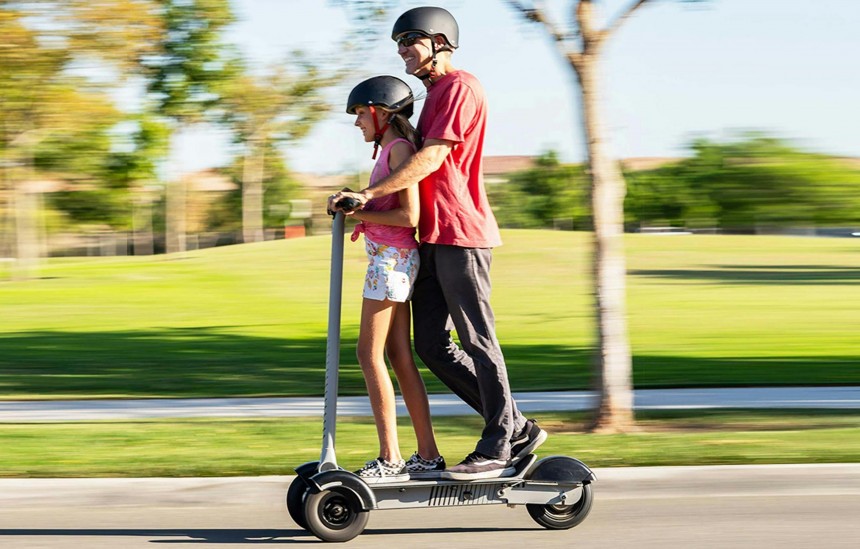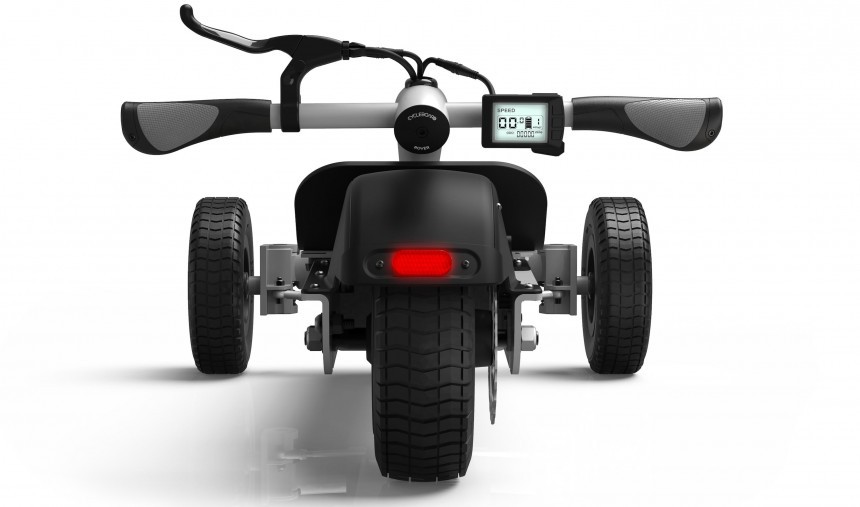This Electric Three-Wheel Scooter Is So Strong You Can Tow Your Kids Around Town
I remember growing up and riding the streets and trails of Phoenix, Arizona, with just about anything I could find. Years later, an electric scooter has grabbed my attention and just won't let go.
That's right; I just can't seem to take my eyes off CycleBoard's Rover, the electrified three-wheel vehicle before us today. Yes, CycleBoard dares call this device a "vehicle," and by the time we're done here, you might agree with that statement.
Now, what makes this thing so attractive in my book is the amount of power it has in store and what you can do with it. There's a little video below to show you what I'm talking about. Better yet, leave that video for last as a sort of cherry on top of today's cake.
To cut to the chase, I'm talking about that 1,800 W motor strapped to the Rover's rear wheel, the source of a top speed of 27 mph (43 mph). While it's not the fastest thing on the road, try and picture the Rovers as more of a diesel, and I say this because - spoiler alert - there are shots in the video below that reveal riders towing cargo behind them, including children, all the while, loaded up with things like groceries hanging out in a front basket.
Photo: CycleBoard
Furthermore, CycleBoard also mentions that the Rover can conquer hills of up to 30%, but this statement comes with an asterisk, and I couldn't find what that fine print is supposed to say. It might have something to do with the Rover's ability to handle such angles "even at slower speeds." In all, 41 Nm (30 lb-ft) of torque is there to push you and your cargo along.
But all that power needs a power source, and the Rover has 1,152 Wh of juice strapped into that footboard. With it, the manufacturer states that a peak range of 40 miles (64 km) on a full charge is possible. Clearly, all that depends on things like road and weather conditions and even the lunch you had, so expect that number to drop in the real world.
From a safety side of things, the Rover not only includes hydraulic brakes, but upon pulling the brake handle 35% of the way, an electronic motor kicks in and slows the Rover down without engaging the hydraulic brake. I've had experience with this sort of system before, and it's often accompanied by regenerative braking, but that doesn't seem to be in place on the Rover.

Photo: CycleBoard
Part two of safety has to do with the Rover's design. With two wheels at the front, and an oversized one at the rear, this puppy has got to be rather stable, and once you start getting the hang of leaning into turns, you should be able to do what that gentleman is doing in the video. I'm not going to lie though; this sort of steering setup may take a moment of getting used to.
Then there's comfort, and such vehicles aren't always known to be the most comfortable around. However, CycleBoard managed to widen and elongate the board so that an array of riders can find that sweet spot between being along for the ride and ready for action. The independent suspension added brings even more plushness.
As for how the Rover is built and what it can handle, the main body is crafted using aluminum, and because of the wheel dimension and tread CycleBoard states that the Rover can handle mixed-terrain conditions. Mixed, so nothing too extreme; as long as you keep the wheels planted on the ground at all times, you should be fine.
Last but not least, I do need to pay some extra attention to the fact that the Rover isn't just a scooter—it's a downright beast! With that in mind, note that CycleBoard offers an array of extra features that you can use to really help take this thing above and beyond.

Photo: CycleBoard
Sure, they don't offer any upgraded wheels, motor, or battery pack, but by adding options such as a cargo basket at the front and a cargo trailer at the rear - it can even carry your child - the Rover transforms into a vehicle that fits perfectly into that whole American picturesque neighborhood with its white picket fences. Come Saturday morning, whip it out, and get dirty riding around off-road on some trails behind your house.
But how much is this magic going to cost us? Well, it depends on when you purchase your Rover. Most of the time, this three-wheeling RV was selling for a cool $2,600, but lately, the price has dropped to $2,080 (€1,900 at current exchange rates), so you know, now's really the time to get in on the action if the Rover sparked your interest.
If you still need a bit of an incentive, find one of these in some local outdoor sports store, or order it online and return it within 14 days if you're not happy; classic warranty and all; just make sure to abide by those parameters so you can get your money back. Happy riding out there, and always wear a helmet.

